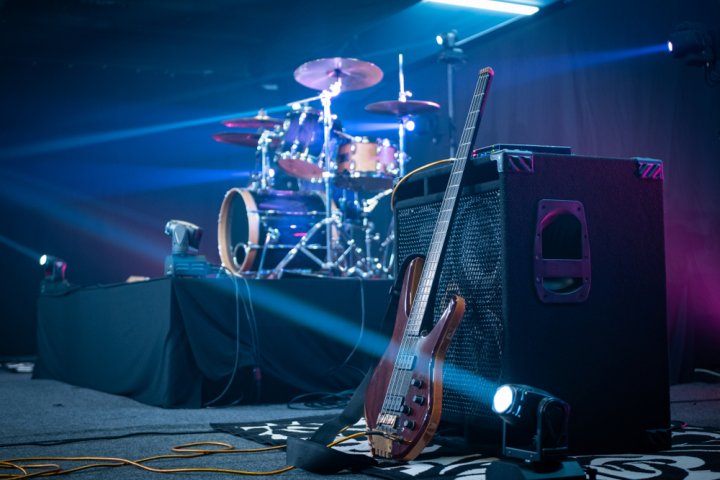Few things in the guitar world are as polarizing as the headless guitar or bass. Some people would sooner be caught dead than seen playing a headless guitar, while others think you’re crazy if you’re still lugging around a heavy guitar with a bulky body and headstock.
Whichever side of the coin you fall on, the fact is that headless guitars bring several benefits to the table. These instruments offer tons of sustain, enhanced playability, and all the tone and warmth you could want from a guitar or bass.
Today, we’re going to take a closer look at the best headless guitars and basses for beginners. We’ll cover headless guitar benefits, headless guitar disadvantages, and everything you’ll need to look for before you decide on an ideal model for you.
The 6 Best Headless Guitars and Basses For Beginners
Without further adieu, let’s take a closer look at the six best headless guitars and basses for beginners.
EART W1
One of the only drawbacks of headless instruments is that there’s a significant void when it comes to affordable options. Most headless guitars eclipse the $1000 mark, which is much more than the average beginner is willing to spend. Enter the EART W1, which boasts high-end looks and features usually reserved for $2000 guitars at a much more palatable price.
The W1 features a gorgeous poplar burl top, an African redwood body, a five-piece rock maple neck, and an Indian rosewood fretboard. This guitar also boasts covered double humbuckers and a well-designed cast bridge that makes tuning and intonation adjustments a breeze.
With million-dollar looks and impressive features, it’s valid to wonder how this guitar is so inexpensive. That’s easy to explain for the most part. After all, who the hell is EART, anyway?
The caveat is EART is a brand new company that doesn’t have much of a track record. It’s anyone’s guess if they’ll be around for the long haul. One thing is for sure, the W1 delivers incredible value for the price, and it can stand toe-to-toe with far more expensive guitars.
Pros
- Beautiful poplar burl top
- A generous selection of exotic tonewoods
- Meticulous fretwork makes for a comfortable neck
Cons
- Mediocre pickups
- Relatively unknown manufacturer
Ibanez Q54
This Ibanez headless guitar leverages decades of experience to create a gorgeous instrument that covers tons of sonic territory without a pesky headstock to get in the way.
This Ibanez features a Nyatoh body with a 3-piece maple and Bubinga neck. The fretboard is a gorgeous bird’s eye maple that sets the look of the guitar on fire. The Q54 is outfitted with an HSS pickup configuration and 9-way switching, so it’s able to tackle everything from blues and jazz to pop easily, rock, country, and metal.
The frets have an innovative 8-degree slant that improves playing ergonomics and makes for an exceptionally comfortable instrument. The body and neck are also beautifully balanced, so this guitar is comfortable whether you’re standing or seated.
Pros
- Ergonomic design
- Excellent bridge with extended intonation range
- Legendary Wizard neck profile
- 9-way pickup switching for an impressive range of tones
- Made in Japan
Cons
- Mediocre pickups
- Only available in black or seafoam green
Ibanez EHB1500 Bass
Ibanez has a storied history manufacturing basses, and they’ve channeled their decades of innovation and experience into the headless bass game with the EHB1500. This headless bass from Ibanez is loaded with high-end features and gorgeous tonewoods, and it’s sure to turn heads on stage.
This bass features an African mahogany body with a gorgeous poplar burl top. The exotic neck is a 9-piece sandwich of panga panga and walnut, and it’s finished with a bound panga panga fretboard.
The EHB1500 features a monorail bridge that helps limit sympathetic vibration. Each rail is double anchored to the body, which increases resonance and sustains, making for an incredible sounding instrument that performs as well as any custom shop bass.
Rounding out the EHB1500 are Nordstrand Big Split active pickups, a 3-band EQ with bypass switch, luminous dot markers, and Schaller strap locks.
Pros
- Gorgeous exotic tonewoods throughout
- The beautiful bridge design improves resonance and sustain
- Excellent stock pickups
Cons
- Fairly pricey
- It still has a nut above the 0 fret
Steinberger Spirit GTPRO
The one that started it all, this classic Steinberger has been an industry-leading headless guitar for well over three decades now. While it might not feature the eye-catching design of other headless guitars, it’s packed with playability and performance features that have made it one of the most enduring designs in rock history.
The GTPro offers a poplar body with a 3-piece maple neck and basswood composite fretboard.
The Steinberger Spirit GTPro offers all Steinberger electronics, including HB-1 and HB-2 humbuckers, with an SC-1 single-coil in the middle position.
A locking R-trem tremolo system allows you to divebomb to your heart’s content, and a flip-down leg rest pulls out whenever you like, so your posture is always on point as you play.
There’s a reason why this is such an enduring design. The GTPro is lightweight, has an excellent bridge design, and has quality electronics to ensure your playing sounds its best.
Pros
- Excellent bridge design
- Surprisingly comfortable to play
- Unbeatable Steinberger lifetime warranty
Cons
- Basswood composite fingerboard? Hard pass.
- Requires Steinberger brand strings
Strandberg Boden
Ned Steinberger sparked a revolution with his headless instruments, and Ola Strandberg has taken it from there. Strandberg has ascended to the throne as the best headless guitar manufacturer, and their Boden model is one of the best in the business.
The Boden offers a basswood body with a thick figured maple top and a roasted maple neck and fingerboard with their patented EndurNeck profile, promoting proper playing posture. The multiscale fretboard helps improve tone while making lead playing on the treble strings easier than ever.
The bridge is well-designed and delivers excellent tone and adjustability, while the direct-mount Strandberg pickups offer all the cutting tones you could ever want.
Pros
Ergonomically designed for comfort in any playing position
- Multiscale neck with the EndurNeck profile
- Perhaps the most comfortable guitar to play in the world
Cons
- Difficult to tune
- Mediocre pickups
Steinberger Spirit XT-2 Bass
Bass players, rejoice! The Spirit XT-2 is basically a carbon copy of Steinberger’s wildly popular Spirit XL series guitars, reimagined for bass players.
The XT-2 features a maple neck and body with a rosewood fingerboard and 24 fret scale. The Steinberger-designed bridge with a 40:1 direct pull tuning system is another standout, and it’s still one of the most effective headless instrument designs on the market.
EMG Select humbucker style pickups round out this powerful bass, which offers independent volume controls and global tone control for crafting your sound.
Pros
- Excellent bridge design
- Lightweight and comfortable to play
- Flip-down kickstand improves playing posture
Cons
- Mediocre pickups
- Requires Steinberger brand strings
Headless Guitar and Bass Buying Guide
Are you looking for the best headless guitars and basses? Before you head to the store and purchase the first model that catches your eye, there are several important factors you’ll want to consider.
Headless Guitar Design
Understanding how headless guitars are designed makes it easier to wrap your head around the features that make them desirable.
Since there’s no headstock, that also means there are no tuning pegs. Headless guitars terminate just above the “zero fret” of the guitar, and the strings attach to a component at the top of the neck that’s similar to a traditional tailpiece.
The bridge features individual saddles with knobs to adjust string tension, which is how to tune a headless guitar. As you turn the knob, the tension on the strings is increased or decreased, which creates changes to the tuning. Intonation is also handled at the bridge saddles, so the guitar plays in tune throughout its scale.
Benefits of Headless Guitars
When it comes to a headless guitar vs. normal guitar, a few characteristics make headless instruments more comfortable and playable. Headless purists also argue that these guitars offer increased sustain, more precise intonation, and they stay in tune better.
The lack of a headstock and the more compact body make these guitars significantly lighter than traditional instruments. So, there’s less stress on your shoulders and neck when standing up. These guitars also help you maintain a natural playing posture when you’re standing.
Since there’s no extra string material above the nut and wrapping around the tuning pegs, there’s also less string to be affected by your playing and ambient environment. These characteristics translate to better tuning stability. Making tuning changes is also easier and can be made on the fly with your picking hand right at the bridge.
Headless guitars also offer better sustain, primarily because of the lack of a headstock. When a traditional guitar sustains, the strings above the nut vibrate at a different frequency to the strings below it. These two competing vibrations effectively cancel out some of the sustain you should get, which isn’t an issue with headless guitars or basses.
The final benefit of headless guitars and basses is they don’t produce any noise above the nut the way instruments with headstocks do. When you play precise rhythmic passages, especially through a high-gain amplifier, you’ll hear all sorts of strange relics in your tone if you listen carefully. This phenomenon has driven metal and progressive guitarists up a wall for years.
Sure, you can purchase something to dampen the vibrations above the nut or wrap a dish towel around your headstock. Or, for practicality’s sake, you could just do away with these annoying noises altogether by opting for a headless electric guitar or bass.
Disadvantages of Headless Guitars
Headless guitars address many of the problems inherent with traditional guitars, and there are virtually no real drawbacks to using one over a conventional instrument.
Some players aren’t fond of these guitars’ look; instead, they stick with a classic-looking instrument at the expense of their tone, sustain, and playability. Once you get over any aesthetic concerns you may have, it becomes clear that a headless guitar is a wise choice.
The only other drawback of these guitars is that most of them are geared towards semi-pro and professional musicians. While you’ll find no shortage of traditional guitars for under $200, most headless guitars and basses are professional-quality instruments that carry a higher price tag.
Outside of these minor caveats, there’s no reason not to play a headless guitar or bass.
Final Verdict: Are Headless Guitars Good?
When it comes to headless guitars and basses for beginners, once you learn a few of the factors that differentiate these instruments from their standard counterparts, it’s easy to see why they’re an excellent choice.
From better sustain and quieter response to reduced weight and a more comfortable feel, headless guitars and basses are clearly the future of the instrument. So, why bother with a clumsy headstock and bulky body when you can ascend to the next level? Check out a headless guitar or bass today!







